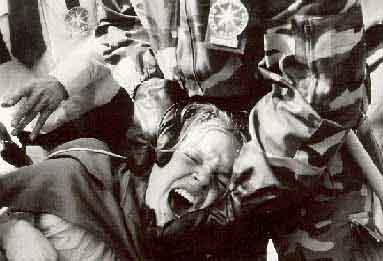
"Continuance of present government neglect
(of the health effects of radioactivity)
is at best irrational and at worst genocidal."
- Dr.
Rosalie Bertrand

Did You Know...
- That all of the 14 western OECD countries (except France) that started
nuclear power programs have finished construction or canceled all their
remaining reactors and have no serious plans for new reactors? But at the
same time, all the largest ones are trying to export nuclear technology
to Eastern Europe
- That the largest nuclear production industry in the world, Electricite
de France, has accumulated a debt of over 30 billion US dollars, making
it the most endebted company in the world
- That the largest corporate debt default in history involved a US utility
in Washington State which subsequently lead to the shutdown of its completed
nuclear plant even before startup
- That the Italy closed three running reactors after a national referendum
on nuclear, Austria did not start up the 100% Zwentendorf reactor after
a referendum to close it passed, and the 100% complete Shoreham reactor
in the US was not brought to full power after it was discovered that operating
costs alone were greater than alternative solutions
- That there are 434 nuclear reactors operating worldwide and 34 more
under construction.
- That the biggest nuclear "financial meltdown" still awaits
us: decommissioning of NPP's. Estimates range from 10 to 100% of construction
costs (up to US$3 bil. each) for decommissioning
- That after Chernobyl and Three Mile Island, the International Atomic
Energy Agency assessed the probability of major accidents to be on an average
of one serious "core melt" accident somewhere in the world, every
2.5 years
- That in Germany the police guarding radwaste during transport can only
stay on the train for 50 km at which point they have have recieved the
full dose permited by law.
- That the builder of the nuclear plants in the world, Westinghouse,
built 54 commercial reactors in the US, which were on average 432% over
budget and 5.3 years delayed The last one was Watts Bar I, 23 years late
and 1100% over budget at an incredible US$7 billion
- That up to 1983, European countries alone disposed of some 60,000 cubic
meters of low and intermediate level wastes in the Atlantic ocean
- That nuclear energy was once heralded as an energy resource "too
cheap to meter." But now it is the most expensive commercial source
of electricity in the US today at 9 cents/kWhr, more expensive than commercial
wind (5 to 7 cents/kWhr)?
- Studies by conservation experts show that since 1980, energy efficiency
gains have saved five times as much energy as nuclear plants have produced
in the United States.
- That after 40 years of nuclear power, there has never been a secure
method for dealing with high level wastes and the average reactor produces
25 tons of high level waste yearly
- That Germany and Swizterland have negotiated with China to dump highly
radioactive wastes in their country
- That the British government had to pass legislation requiring a proportion
of the national generating capacity should be reserved for nuclear power,
in order to prevent the collapse of this sector?
- That Electricite de France (EdF) now sells eletricity at a loss to
entice both domestic and industrial consumers to purchase it rather than
the far cheaper primary fuels such as natural gas By EdF's own estimates
they have 7 more reactors than they need, yet they keep on building them.
- That State-of-the-art wind power, once considered a far-off dream,
is now capable of producing electricity at half the cost of nukes.
- That Dr. John Gofman, a one-time AEC expert on radiation and health,
estimates the cancer toll in the former Soviet Union and Eastern Europe
at 500,000 over the next century, dwarfing the combined body count from
both Hiroshima and Hagasaki.
- That US President Richard Nixon had promised 1,000 reactors by the
year 2000 in the US; however, every reactor ordered since October 1973
has been canned and no new reactors are in the U.S. pipeline.
- By 1974, the US had 236 reactors operating, under construction, or
on the drawing board, but the industry reached its online peak in the late
1980s with fewer than 120 operating reactors.

Resistance | Brain
Food | The Players | '97Blockade
| Links | CEB | SPACE


![]()